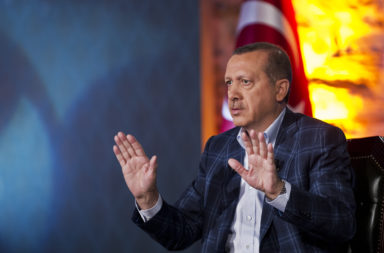Portugal received an influx of 1 million people in 1975, almost 10% of its population at the time.
Similar numbers have been witnessed before across the Middle East at various points in time, and indeed, greater volumes are currently being experienced among Syria’s neighbours today. Admittedly, in 1975 Portugal was receiving migrants from Portuguese speaking colonies. And in the Middle East today, the vast majority of refugees being resettled speak the language of the country into which they are being settled.
But learning a language can only be so hard. And cultural differences can only be so great.
So to say that integrating Syrian refugees into Lebanon or Jordan, or that doing so for Angolans in Portugal can’t teach us a few things about how the world could act to receive refugees today, is to seriously underestimate the lessons to be learned from history.
Indeed, as Mark Twain once wrote “if history doesn’t repeat itself, it certainly rhymes.”
The “rhyme” in today’s context, is that these significant achievements should serve as an example of how if we’ve done it before, we can do it again. Portugal has proven just how capable nations are of receiving a sudden and significant influx of migrants. And it has gone beyond this, demonstrating an understanding of the positive benefits that such migrants bring to the country. Indeed, only last week it offered to receive 10,000 Syrian refugees at a time when many countries are better equipped economically to respond to this crisis.
The United States for example, has also offered to receive 10,000 Syrians. However, as a country 30 times larger than Portugal, with wealth per person that is 2.5 times than Portugal, this is hardly a momentous undertaking.
And that’s to say nothing of the rest of Europe.
Admittedly, Germany settled over 1 million refugees during the course of 2015. Yet at a little over one percent of its population during a time where the German economy is moving from strength to strength, this act alone means that the European superpower is hardly in a position to compare itself to Portugal in 1975.
So just what would it look like to respond to this crisis in a comprehensive manner?
Well to begin, it would start with housing and feeding all asylum seekers while their claims are processed. We currently have a little over 15 million refugees with applications before the United Nations High Commission on Refugees (UNHCR). If the world were to house asylum seekers at the annual cost estimated by the Australian and American governments of between $15,000 and $15,700 USD, then we would be looking at a total cost of a little over $235 billion.
Given that the United States was able to mobilise $787 billion in a period of a little under 6 months to save its largest banks, it is conceivable that it could summon a resource base less than three times this size, in order to save and protect those most in need. Moreover, as the crisis rolls into what is now its sixth year, one must imagine that we are hopefully drawing closer to a solution.
Many will respond to this by arguing that this is unfair. America had to respond to the financial crisis or risk destroying the entire global monetary architecture. This may indeed be true. Yet surely we consider the protection of peoples in war torn regions to be more significant than the financial system which we utilise. Moreover, the current refugee crisis is global in nature. And it would be significantly less costly to resolve than the financial crisis, as has been demonstrated above.
While some may respond that this is only the annual estimated cost of housing and feeding asylum seekers while their claims are estimated, it is important to bear in mind that in Australia to take one example, 75% of applications are processed inside of one year. Given the scale and nature of this problem, dedicating a significant amount of resources to this problem would help to streamline processing times and indeed, reduce costs associated with such a process.
So how would one begin to respond to this crisis? Well firstly, the world would need to commence resettling the 15 million refugees somewhat evenly among the thirty countries that have thus far volunteered to respond to the crisis.
This would mean roughly half a million refugees being settled on average in most countries, with much larger nations such as Germany and America receiving a good deal more.
It would mean the marshalling of resources, which at $235 billion would equate to an average of $7.8 billion per nation, with richer and larger countries, again shouldering the greater part of this burden. And to put these numbers into context, such an expenditure would only amount to one tenth of the annual cost of America maintaining its military presence inside Afghanistan over the past decade.
For those that continue to argue that the resources simply are not available to finance such activities, I would argue that the cost of settling refugees inside of one year is still less than the cost of various military efforts of western states in the Middle East, which have thus far been financed with relative ease.
Leaving aside the painful irony that Western misadventure in Iraq and Afghanistan caused many of these refugees to have to seek asylum in the first place, let’s simply look at the cost of such adventures and assess whether or not the resources exist in the west to address such problems.
To begin, America alone has managed to spend between $2 and $5 trillion to finance its efforts in Iraq according to some estimates. It was again capable of doing so for during its time in Afghanistan. And this is to say nothing of the coalition forces that supported and joined America in these forays.
Therefore, it is clear that America on its own, has demonstrated the ability to raise significant capital to support its own military and financial interests. In fact, so significant have such efforts been, that they have exceeded the entire cost of resettling all refugees globally. With the assistance of an additional 29 countries across the world, just imagine what is capable.
This is all to say nothing of the arguments made for resettling refugees. Those have been made time and again. We know that there is simply an urgent, humanitarian and moral requirement for us as global citizens to respond to this crisis. We know that there are geo-strategic and foreign policy interests in us accepting those fleeing despotic, military and repressive regimes. And finally, we know that refugees are resourceful, young and entrepreneurial in nature.
Countless refugees have already contributed to the countries that have received them. We know that the founders of Google and Apple, to name just a few, are the products of migrant families. And we know that as the west ages, it faces a declining working population. This problem would be best resolved by accepting young, dynamic citizens who are eager to learn and to work. This profile describes the average asylum seeker almost exactly.
Finally, for those concerned about the permanent cultural integration of broadly disparate societies, I would point to the tremendous benefits that multiculturalism has brought to countries across the world. If that still fails, it would be worthwhile to remember that up to 90 percent of Yugoslav refugees that sought asylum in Germany during the 1990s ultimately decided to return home once the conflicts in their respective countries of origin were resolved.
And with roughly 50 percent of refugees across the world currently choosing to return home after the cause of their displacement ceases, we can expect similar such results after the conflict in Syria and other regions comes to an end. Refugees certainly require temporary assistance during times of conflict, but ultimately, there is no place like home.
So with such clarity about the path forward from here, and with the understanding that we have nothing but reasons to act, it appears that the only thing left to do is to respond. We know that we have the ability to do so. We clearly have a duty. With that in mind, how dare we do anything but act?




